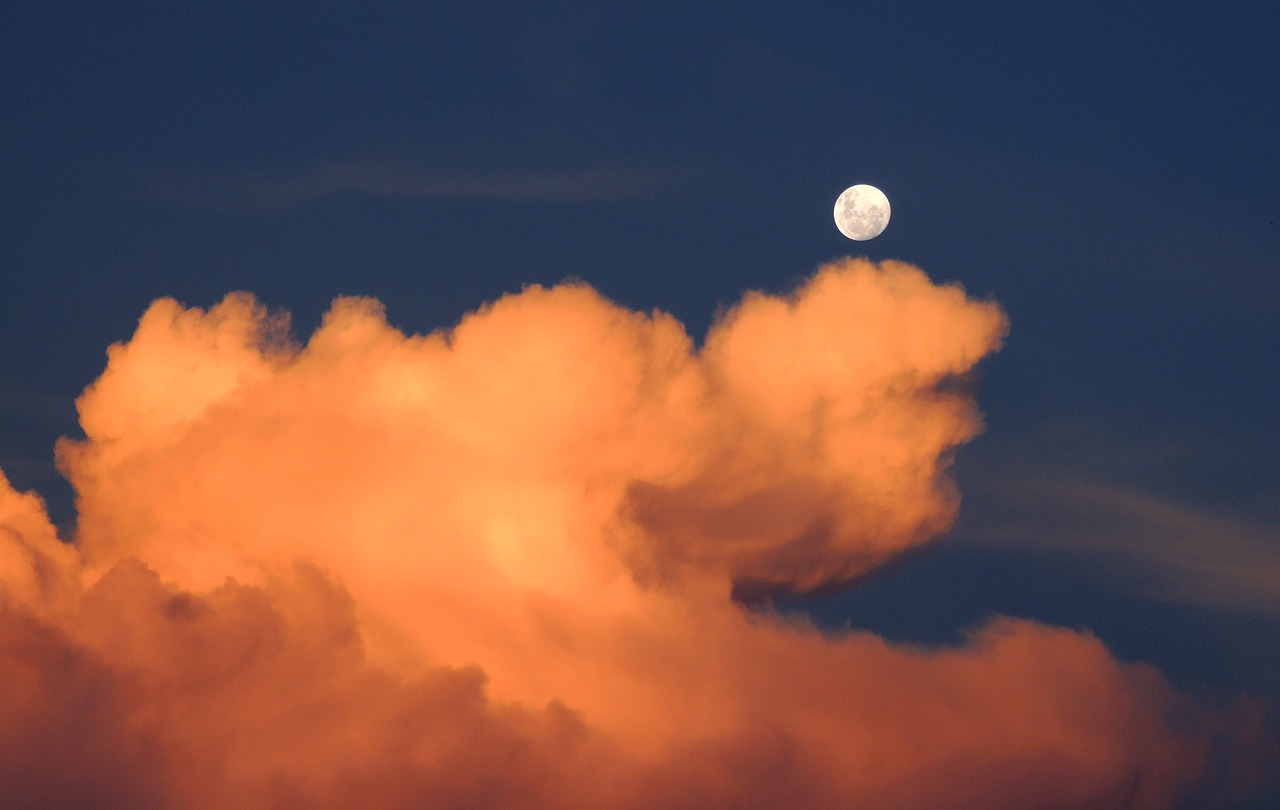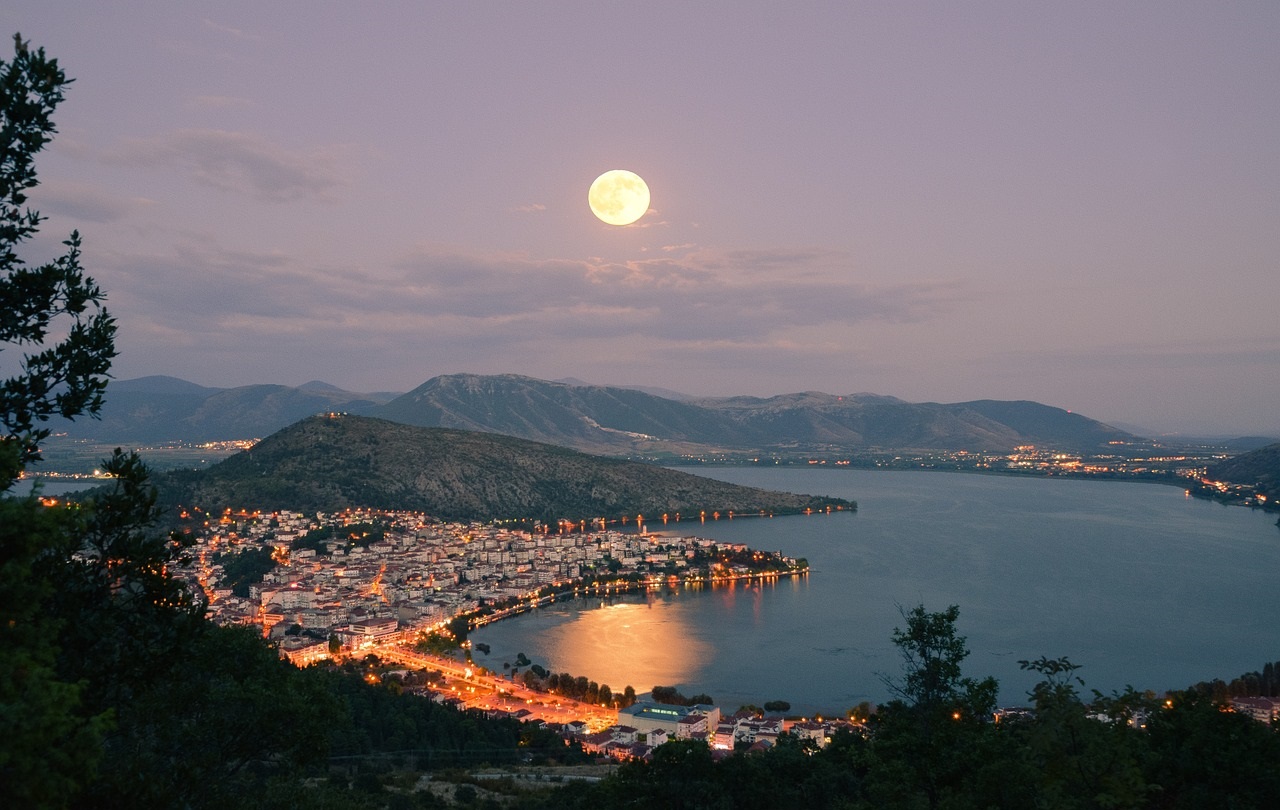Stardust and Eternity – 3.2.1
The Moon, Moonlight and Moon phases
Most of the planets orbiting around the Sun, except Mercury and Venus, have natural satellites. The Earth’s Moon is only the fifth largest of the more than 200 known natural satellites orbiting planets of our Solar System, after Ganymede, Titan, Callisto, and Io, which orbit Jupiter and Saturn. The diameter of the Moon is about 3,500 km, a little more than 1/4 of the size of our planet; its distance is about 380,000 km. The origin of the Moon is still uncertain. It is nowadays believed that a giant impact between Earth and a Mars-sized planet (the so-called “Theia hypothesis”) occurred around 4.5 billions years ago, resulting in the ejection of debris into orbit around our planet, eventually coalescing to form the Moon. A heavy meteorite bombardment occurred soon after the solidification of the Moon’s crust, resulting in its characteristic cratered appearance. Prominent lunar “mare” basins were also formed and later filled with basaltic lava flows due to volcanic activity, creating the curious dark patterns that can easily be seen by eye during a full moon. Since our satellite rotates on its axis exactly once for every revolution it makes around the Earth – in a so-called “synchronous rotation” – we are only able to see one “face” of the Moon, while the “dark side” was only been mapped after a series of lunar orbiter missions launched after 1966 by the United States.
The Moon has no atmosphere and does not emit light but reflects the light of Sun. The “moonlight” is thus only a reflection of the sunlight and is very weak as compared to it. Due to its low “albedo”, only the 12% of the incident sunlight is reflected from the lunar surface. The moonlight is further scattered into the Earth’s atmosphere – thus increasing the brightness of the night sky and contributing to the light pollution that reduces our chance to observe dimmer stars. Moonlight’s intensity varies significantly, depending on the specific “lunar phase”. Indeed, due to its orbital sidereal period of about 27.3 days around the Earth, the visual aspect of our satellite changes continually, thus provoking the so-called lunar phases. They are caused by the reflecting Sun-illuminated portions of the Moon. Actually, the span of time between two successive full moons is a little bit longer – 29.5 days, or a “synodic month” – because at the same time the Earth also revolves around the Sun. The “new Moon” is the first lunar phase; it occurs when the Moon is between the Earth and the Sun, so that the lunar surface facing toward our planet receives no direct sunlight. Vice versa, when the Earth is between the Sun and the Moon, in its third phase, the face of the Moon is completely lit by the Sun and we experience a “full Moon”. “Half Moons” – the second and fourth lunar phases – occur when only half of the surface facing the Earth is lit by light. While the above mentioned four characteristic lunar phases last only one night, for about 7 days the Moon has a characteristic “waxing” or hump-backed shape between the first-quarter Moon and the full Moon, and a characteristic “waning” or shrinking sickle shape between the third quarter Moon and the new Moon.

Further Resources
Links below will redirect you to external websites. In accordance with the European data protection declarations, we would like to point out that by clicking on these links you may send data to external providers. We cannot prevent that.
Images
![]() Full Moon Photographed From Apollo 11 Spacecraft (NASA)
Full Moon Photographed From Apollo 11 Spacecraft (NASA)
![]() Apollo 11 Mission Image – View of Moon Limb, with Earth on the Horizon (NASA/JSC)
Apollo 11 Mission Image – View of Moon Limb, with Earth on the Horizon (NASA/JSC)
![]() Lunar interior (Kenneth R. Lang, Tufts University)
Lunar interior (Kenneth R. Lang, Tufts University)
![]() Internal Moon structure (ESO/N. Bartmann)
Internal Moon structure (ESO/N. Bartmann)
![]() Giant impact hypothesis for the origin of the Earth’s Moon (Kenneth R. Lang, Tufts University)
Giant impact hypothesis for the origin of the Earth’s Moon (Kenneth R. Lang, Tufts University)
![]() Super Moon vs. Micro Moon (Catalin Paduraru, APOD)
Super Moon vs. Micro Moon (Catalin Paduraru, APOD)
![]() Colors of the Moon (Marcella Giulia Pace, APOD)
Colors of the Moon (Marcella Giulia Pace, APOD)
![]() Phases of the Moon (NASA)
Phases of the Moon (NASA)
![]() Phases of the Moon (Kenneth R. Lang, Tufts University)
Phases of the Moon (Kenneth R. Lang, Tufts University)
Videos
![]() Moon 101 (National Geographic)
Moon 101 (National Geographic)
![]() Direct from the Moon (National Geographic)
Direct from the Moon (National Geographic)
![]() The Moon (Crash Course Astronomy)
The Moon (Crash Course Astronomy)
![]() Moon Phases (Crash Course Astronomy)
Moon Phases (Crash Course Astronomy)
![]() Origin of the Moon (NASA)
Origin of the Moon (NASA)
 La Terra e la Luna (HUB Scuola)
La Terra e la Luna (HUB Scuola)
 La Luna: caratteristiche e movimenti del nostro satellite (Scienza channel TV)
La Luna: caratteristiche e movimenti del nostro satellite (Scienza channel TV)
 La LUNA: storia, numeri, curiosità, maree e altri dati scientifici sul nostro satellite (AstroPills)
La LUNA: storia, numeri, curiosità, maree e altri dati scientifici sul nostro satellite (AstroPills)
 Ecco Perché La Luna Cambia Sempre Forma Nel Cielo (IL LATO POSITIVO)
Ecco Perché La Luna Cambia Sempre Forma Nel Cielo (IL LATO POSITIVO)
Online Resources
![]() NASA Science: Earth’s Moon (NASA) – interactive
NASA Science: Earth’s Moon (NASA) – interactive
![]() Moon in motion (NASA)
Moon in motion (NASA)
![]() Moon missions (NASA)
Moon missions (NASA)
 Luna, caratteristiche, formazione e curiosità sul nostro unico satellite naturale (Geopop)
Luna, caratteristiche, formazione e curiosità sul nostro unico satellite naturale (Geopop)
 Perché la Luna si può vedere anche di giorno? La spiegazione scientifica (Geopop)
Perché la Luna si può vedere anche di giorno? La spiegazione scientifica (Geopop)
 Luna (EduINAF)
Luna (EduINAF)
 L’origine della Luna: ecco perché è così simile alla Terra (Focus)
L’origine della Luna: ecco perché è così simile alla Terra (Focus)
 La Luna nasce da un impatto planetario o da una nube rovente? (Focus)
La Luna nasce da un impatto planetario o da una nube rovente? (Focus)
Further Readings
![]() The Moon: A Biography (David Whitehouse)
The Moon: A Biography (David Whitehouse)
![]() The Moon in Close-up: A Next Generation Astronomer’s Guide (John Wilkinson)
The Moon in Close-up: A Next Generation Astronomer’s Guide (John Wilkinson)
![]() The Moon A History for the Future (Oliver Morton)
The Moon A History for the Future (Oliver Morton)
![]() Moon A Brief History (Bernd Brunner)
Moon A Brief History (Bernd Brunner)
![]() Moon Nature and Culture (Edgar Williams)
Moon Nature and Culture (Edgar Williams)
![]() Moon Observer’s Guide (Peter Grego)
Moon Observer’s Guide (Peter Grego)
 Origine della Luna: una ricerca ci avvicina alla soluzione del mistero
Origine della Luna: una ricerca ci avvicina alla soluzione del mistero
 La luna secondo Parmenide (Livio Rossetti)
La luna secondo Parmenide (Livio Rossetti)
Teaching Material
![]() Borrow the Moon (UKRI)
Borrow the Moon (UKRI)
![]() Exploring the Moon (NASA)
Exploring the Moon (NASA)
![]() The Moon (LPI)
The Moon (LPI)
![]() The Moon (Teacher planet)
The Moon (Teacher planet)
 Percorsi didattici sulla Luna e gli altri satelliti del sistema solare (EduINAF)
Percorsi didattici sulla Luna e gli altri satelliti del sistema solare (EduINAF)
For Kids
![]() Over (to) The Moon (Crash Course Kids video)
Over (to) The Moon (Crash Course Kids video)
![]() Why Does the Moon Change? (SciShow Kids, video)
Why Does the Moon Change? (SciShow Kids, video)
![]() Phases of the Moon (Astronomy and Space for Kids – FreeSchool video)
Phases of the Moon (Astronomy and Space for Kids – FreeSchool video)
![]() All About the Moon (Astronomy and Space for Kids – FreeSchool video)
All About the Moon (Astronomy and Space for Kids – FreeSchool video)
![]() Phases Of The Moon (Peekaboo Kidz, video)
Phases Of The Moon (Peekaboo Kidz, video)
 Luna: caratteristiche, movimenti della luna, fasi lunari, eclissi e maree (Facciamo Scienze video)
Luna: caratteristiche, movimenti della luna, fasi lunari, eclissi e maree (Facciamo Scienze video)
 Paxi e la Luna: le fasi e le eclissi (ESA video)
Paxi e la Luna: le fasi e le eclissi (ESA video)
 la luna spiegata ai bambini dell’Infanzia (video)
la luna spiegata ai bambini dell’Infanzia (video)
 In Viaggio nello Spazio con Margherita Hack – La Luna (video)
In Viaggio nello Spazio con Margherita Hack – La Luna (video)
 Le Fasi lunari (Rai Gulp video)
Le Fasi lunari (Rai Gulp video)
 Luna spiegata ai bambini, cosa sapere sull’affascinante satellite (Nostrofiglio.it)
Luna spiegata ai bambini, cosa sapere sull’affascinante satellite (Nostrofiglio.it)
 FASI LUNARI: UNA SPIEGAZIONE PER I BAMBINI, SEMPLICE E CHIARA (Fruttolo.it)
FASI LUNARI: UNA SPIEGAZIONE PER I BAMBINI, SEMPLICE E CHIARA (Fruttolo.it)

